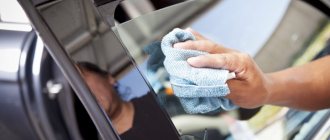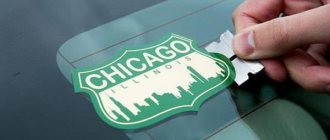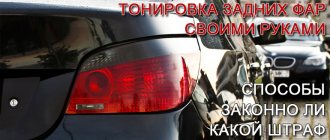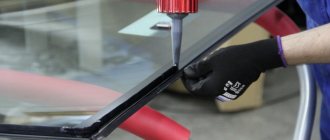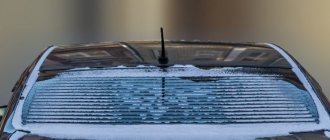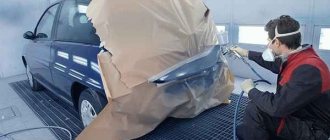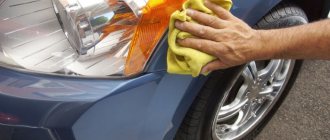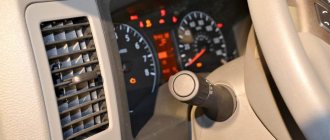Removing tint with a hairdryer
How to remove the film itself? You'll have to remember your school chemistry course. The film consists of a polymer material, and all polymers are destroyed when heated. It turns out that to carefully remove the film you need to heat it with a stream of hot air. Any hair dryer that is usually used to dry hair is suitable for this. In this way, you can peel off the tint almost without streaks.
The main thing is not to exceed the temperature of 40 degrees Celsius, otherwise the film will melt and stick tightly. Or the glass will simply burst. The method is practically professional, relatively affordable and working.
The procedure consists of several stages:
- First, the side window lowers a little.
- All rubber seals are removed.
- Using a hair dryer, the surface of the glass is heated so that the film softens but does not melt.
- Then it is pryed with a knife and moved slightly to the side.
- The film is gradually removed from the entire surface.
Now let's look at popular methods for removing glue from the surface of glass.
How to wipe the glue off the tinting from the glass yourself and clean
I really don’t understand the situation when young “boys” drive fully tinted cars, because you can only darken the rear side and main windows. Sooner or later the police will catch them and issue a fine. Of course, now there are various types of electronic tints, but I don’t think that the guys on lowered PRIOR cars install these on themselves, because their cost will be higher than their entire car. In general, sooner or later, having “had enough” of fines, you will have to tear off the front tinting. You can do this yourself, but you need to do it correctly, because there may actually be glue left on the glass, which is not so easy to remove. Today I will give you some tips on how to remove it yourself.
How to remove tinting glue from a car window yourself video:
Using soap solution
As a preparation, you can use almost any detergent at hand. The work consists of steps:
- Tinted glass is coated with a solution. Then newspaper is applied to the wet surface, which quickly sticks.
- For 2 hours, the newspaper is constantly wetted with the solution.
- This leads to a softening of the tint. As a result, the film can be easily removed together with the newspaper.
The advantage of this method is that there is no need to search for a soap solution.
Safety precautions
When working with aggressive agents, you need a mask, gloves and goggles.
Most chemicals and folk remedies are toxic and have a pungent odor that lasts for a long time. They can cause burns to the mucous surfaces of the respiratory system. Contact with skin leads to the formation of wounds, so you need to work with them carefully.
Do not smoke while working and generally do not clean near an open fire or near hot objects. Concentrated vapors may cause fire.
Before carrying out work, you should take care to follow safety precautions and prepare safety glasses that will save your eyes from contact with chemicals. A respirator, or in extreme cases a gauze bandage, will protect the respiratory system. Rubber gloves will protect your hands from chemical burns.
Sometimes you have to tint the windows on loggias and in apartments - glue a shading film on them. If you are tired of the darkening or the film needs to be replaced, you can do this in the same way as in a car: first remove the film, then wash off the remaining adhesive base.
Using ammonia
This work is carried out on a sunny day using ammonia. The work order consists of stages:
- A soap solution is diluted to cover the glass. Ammonia is applied on top.
- Small pieces of polyethylene are cut, which after wetting in ammonia are glued to the glass.
- Ammonia and sunlight affect the film. Over time it softens. After this, removing it is not difficult.
This method is harmful to health, so work must be carried out exclusively in a respirator. Ammonia vapors are dangerous.
Characteristics of tint film
Car window tinting allows drivers to reduce the heating of the cabin by sunlight, improve the appearance and hide the contents of the cabin.
Tinting meets the following characteristics:
- degree of light transmittance;
- shade;
- adhesive base;
- protection from ultraviolet waves.
The light transmission parameter is determined by the percentage on the film package. The higher the value, the lighter the tint. There are several main types:
- 5%;
- 10%;
- 15%;
- 25%;
- 35%.
The rear hemisphere is usually covered with a material with an indicator of 5%. This ensures a significant darkening of the interior and does not interfere with visibility when driving.
Tinting the strip on the top of the windshield is done using 10-15% tint. The choice of this value is justified by the fact that the film transmits a lot of light, so the driver is not distracted while driving. The width of the strip should not exceed 140 mm at any measurement point.
It is prohibited to darken the front side windows, but drivers ignore the rules and apply material with 35, 25, 10 and even 5% markings. In sunny weather, this has virtually no effect on visibility, but in twilight or rain, the film produces glare and reflects the driver's face, seriously impairing visibility.
The shade of the material depends on the choice of the buyer and can be:
- black;
- dark blue;
- blue;
- dark brown.
In Chinese models there are shades of red, green and yellow. Original expensive materials are usually offered in black or blue.
The tint is held on the surface by a special transparent glue. The quality of the composition directly depends on the manufacturer and the cost of the product. Cheap materials often have cloudy spots that significantly impair visibility.
Ultraviolet radiation has a negative effect on human skin, elements of the center console and leather upholstery. High-quality tinting includes a coating that refracts harmful rays. Cheap products cannot boast of such an ability.
Traditional methods of removing glue
In principle, you can also quickly and barbarically tear off the coating, but then sticky traces of glue will remain. How to remove them:
- alcohol glass cleaner;
- soap solution mixed with ammonia (take care of your respiratory system!);
- use a hair dryer and spray bottle to speed up the process;
- Prepare a cleaning solution from dishwashing liquid.
In some situations, even ordinary boiling water fresh from the kettle will help. But this method is only good when it’s warm outside: in winter, such experiments can cause the glass to crack. Just pour a little water on the areas with traces of glue and it will come off.
Porous fabrics (bandage, gauze) remove glue well. Often they don’t need to be impregnated with anything if the tint was removed recently and the glue has not dried. They themselves absorb dirt well. To speed up the process, it is enough to use a biosolvent.
You can use WD40 (rust converter) fluid in combination with a melamine sponge. The result is one hundred percent. You can also prepare a soap solution with formic alcohol instead of ammonia: this will allow you not to wear a respirator and not have to endure the pungent smell of the volatile substance. Just in case, it is better to wear gloves and safety glasses: chemistry is chemistry, even if it seems safe.
How to remove remaining tape?
Freshly applied tape can be easily removed. Now, if it was glued on a long time ago, removing it will be problematic. The top protective plate is easily removed, but after it the glue residue remains for a long time. To remove glue residue, you can try the following types of cleaners.
Water
The glue stain you just left behind can be removed with plain water. To do this, just take a clean rag, moisten it with water and try to wipe off the glue, remove the label or sticker.
Stationery knife
A utility knife, like any relatively sharp object, can easily scrape off a stain, but it may leave scratches. To exclude them, you should try using a credit card. Be sure to keep in mind that only dried stains can be removed. The soft, viscous stuff will only smudge.
Scotch tape
In order to remove traces of old tape, there is no need to start with super products. It is enough to try the simplest experiment. Take new quality tape, stick it over the stain and pull it off. It is possible that all the glue from the glass will stick to the new tape and be removed with it.
Vegetable oil
Any of the vegetable oils available in the house will be useful: essential, sunflower, olive.
An additional benefit of essential oil is the fresh aroma it leaves behind in your home.
The oil is applied to the dirty surface and left for 4 to 10 minutes to saturate the stain. After a period of time, the remaining oil is removed with a dry, clean napkin or cloth. In order to remove residual oil, you can use any product that removes grease from surfaces; it cleans together with soda
Use baking soda with caution; it can scratch some types of glass. Oil can also be used as a cleaning agent on other surfaces: plastic, microwave
Wiper
You can try using a regular glass cleaner to remove the glue stain. To do this, apply it in large quantities to the contaminated area, let the dirt soak, and reapply the product. Residues must be wiped off with a clean napkin.
Specialized product
Specialized household chemicals and auto supply stores sell products for removing tape traces. It is enough to purchase them and then wash the glue according to the instructions.
Other solvents
There are traditional solvents; you can try using them to remove stains from super glue or directly from labels and stickers. Before you start cleaning, you should make sure that this product will be safe for your glass and that what you have in front of you is really not plastic. It is advisable to check the effect of the solvent on a corner of the glass, where the resulting negative reaction will be less noticeable. The mechanism of action of the solvent is one: a large amount of the product is applied to the super glue stain, and an exposure time of several minutes is given. An attempt is made to remove the remaining super glue with a hard object.
The following are used as solvents for super glue:
- nail polish remover (just before use you need to make sure it contains acetone);
- petrol;
- kerosene;
- acetone;
- White Spirit;
- vinegar;
- medical alcohol 95%.
Professional products
Currently, many special products are produced for removing glue from glass. For example, aerosol film removers. They are mostly toxic and quite expensive, but they are fast-acting. Here is a sample list of popular chemicals:
- spray “Kerry”;
- “The Anticlean Moment”;
- rust converter “Star Wax”;
- anti-rain Turtle Wax Clear;
- sticker trace cleaner (these are produced under the brands Liqui Moly, Kudo, Spray&Go).
The listed products help to effectively get rid of the marks left by glass tinting glue. Their advantages:
- their active formula is specially designed to remove adhesive stains;
- high quality;
- they are easy to apply;
- some of them have the ability to repel water and work as an anti-rain.
Alternative processing options after film removal
When it comes to removing adhesive residues after tinting, such types of household chemicals as:
- Star Wax rust converter. Russian product. Available in liquid form in 0.5 liter bottles. The effectiveness of the composition is confirmed by numerous reviews from car enthusiasts: the glue can be wiped off without leaving a residue quickly and effortlessly.
The product is old and proven
- “Super Moment Anti-Glue” product. Available in the form of a 5 g tube. It is a gel that is applied to a stain or glue line and dissolves them.
You can buy it at a home store, but the consumption is quite high
- Biosolvent Cytosol. Effectively copes with the problem of cleaning the surface from bitumen or vinyl based adhesives.
Dissolves most tint adhesives
- Profoam 2000. A universal product for removing stickers from any type of surface - outdoor advertising on cars, decorations on refrigerators and doors, etc.
The remainder of the product can be used at home
- 3M 08184. Universal cleaner for various types of glue. Available in aerosol form. After irrigation, all that remains is to wash the resulting waste from the glass.
The 3M 50098 variety is also popular in dealing with adhesive stains from tinting film
Petroleum-containing compounds
Various mixtures of hydrocarbons are known for their solvent effect. They are used to remove traces of stickers, tape, paint and other stubborn dirt. It should be remembered that they are aggressive towards the paintwork of the car. These substances are liquids:
- petrol;
- kerosene;
- white spirit (nefras).
The algorithm for removing glue using these hydrocarbons is as follows:
- Stock up on clean rags;
- Wipe off dirt with a dampened rag;
- Wash the glass with clean water and wipe dry.
You need to work with hydrocarbon liquids with extreme care: they are toxic, volatile, flammable and can damage the paint if they come into contact with body parts.
Basic DIY removal methods
1) Guys, if you find yourself in a situation with a traffic police officer, then try to rip off the film in one motion - you need to pry off the edge with a knife, then take the film with both hands and sharply pull it down as far as you can. It will not be possible to get rid of the adhesive completely, but much less of it will remain.
2) If you have time, you need to pry off the edge of the canvas with a knife and, using soapy water, slowly remove it from the glass. Soapy water is added to the separation area and watered generously so that some of the glue remains on the film. BUT still, it won’t be possible to completely remove it; some of the glue will remain on the glass; it needs to be wiped off differently. But you need to clean it, because you can easily break the window lifts; they will not work because there is glue on the canvas, which will not allow the glass to go down. YES, everything will stick, from dust to all sorts of midges.
Car detonation service
Turning to professionals for help is a smarter decision than removing the tint yourself. Control over car tinting is being strengthened, fines are rising, and drivers are worried. In addition, tint sometimes wears out over time and needs to be renewed. But not everyone has the equipment and free time for this.
The price of tinting per unit at River Auto Lab is 500 rubles. You can be sure that the windows of your car will not be damaged at all. The entire process of glass tinting is carried out in full accordance with technology, which guarantees high quality work even when tinting glass with electrical heating.

